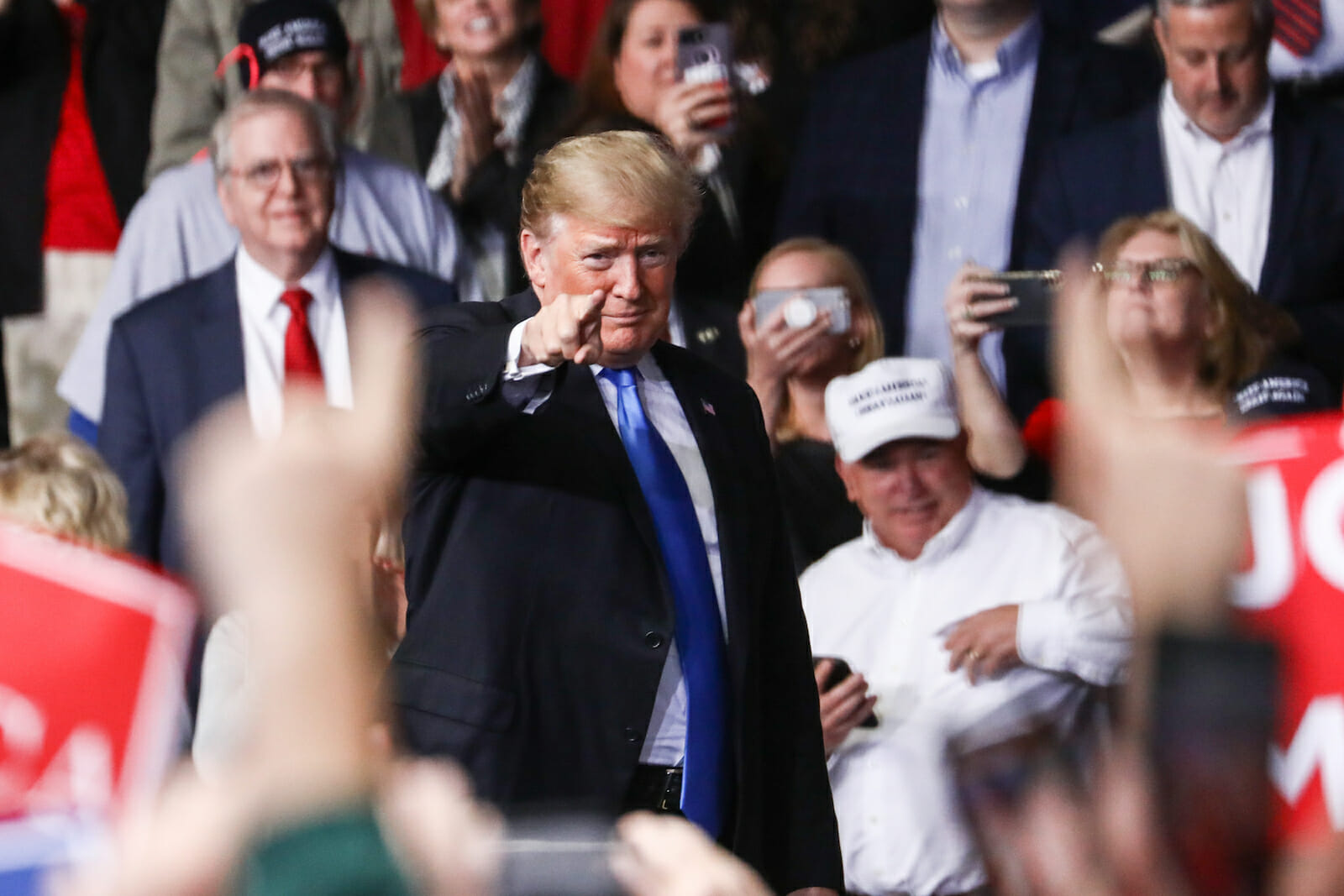
Media
Donald Trump Incites Violence and Conservative Media is Helping Him
Cesar Altieri Sayoc was arrested on October 26, 2018, and was almost immediately identified as the #MAGAbomber, the would-be terrorist who had been sending homemade bombs to the political opponents of Donald Trump. As of Monday evening, George Soros, Hillary Clinton, Barack Obama, Joe Biden, Kamala Harris, Cory Booker, John Brennan, James Clapper, Robert De Niro, Tom Steyer, Eric Holder, Maxine Waters, and CNN had all received packages. All were frequent targets of President Trump.
Sayoc’s arrest happened just as a conservative media theory was beginning to emerge about the attempted bombings: This was all a Democratic ploy to frame a Trump supporter and hurt the Republican Party’s chances in the midterms. In the past, such a theory would have been relegated to the fringes of political discourse, but all throughout the week, it was easily found in even mainstream conservative outlets. Alex Jones — who promotes numerous “false flag” theories — expressed surprise that conservative radio host Rush Limbaugh was basically endorsing this theory on his radio show.
Limbaugh is just one name in a large list that includes others. Ann Coulter, James Woods, Candace Owens, Michael Savage, Lou Dobbs, Dinesh D’Souza, Geraldo Rivera, Bill Mitchell, Congressman Matt Gaetz, and Kurt Schlichter all explicitly endorsed the false flag theory. To be clear, these aren’t nobodies. Lou Dobbs has a TV show that pulls in millions of viewers a night, including the President of the United States. Matt Gaetz is a representative from the same state where Sayoc was arrested. Although most of the #MAGAbomber truthers have faded into the shadows, conservative media’s acceptance of the conspiracy theory is illuminating.
Trump‘s penchant for violent rhetoric is well-documented. In fact, it’s been a feature of his rallies since the early days of his 2016 campaign. Trump was forced to issue his first condemnation of violence only two months after he descended the escalator in Trump Tower: two of his own supporters had beaten up a homeless Hispanic man.
“Donald Trump was right,” the two men said, according to police, as they beat the man with a metal pipe and then urinated on him. “All these illegals need to be deported.”
Not much has changed since 2015. A week ago, at a rally for Congressional candidate Greg Gianforte, Trump cited approvingly Gianforte’s physical assault of reporter Ben Jacobs last year. Compared to Trump’s long history of demonizing the press, it seems like a small drop in a large pond.
On August 30, 2018, Trump tweeted, “I just cannot state strongly enough how totally dishonest much of the Media is. Truth doesn’t matter to them, they only have their hatred & agenda. This includes fake books, which come out about me all the time, always anonymous sources, and are pure fiction. Enemy of the People!” Later that day, investigators announced the arrest of a California man who had been calling into the Boston Globe, making death threats and repeating a lot of Trump’s rhetoric. He specifically called the Globe, “The enemy of the people.”

Even after it emerged that Sayoc had a sticker on his car that proudly proclaimed, “CNN Sucks!,” a pro-Trump crowd gathered at the White House erupted into a chant repeating the phrase. Trump himself has tweeted out images showing him beating a physical representation of CNN.
One of the major problems with Trump’s rhetoric is that the presidency is never the highest crescendo for any sort of political statement, negative or positive. If the president makes some sort of declarative statement, his supporters inevitably make arguments for his position, and at times engage in more heated rhetoric in order to support those arguments. It’s for this very reason that the White House should be temperate and humble when getting involved in politics: your supporters — who are not bound by the microscope of the presidency or restrained by opinion polls — will often make a more extreme version of your argument.
Even when Obama criticized Fox News, he never called them the “enemy of the people,” because he knew someone less responsible than him could always be more (or too) extreme. This has been a pretty standard practice across the modern presidency, but it has obviously ended with Trump. Although he has not called upon his supporters to specifically target the media, Milo Yiannopoulos — a white supremacist Trump supporter formerly employed by Breitbart — told his followers that he wants “vigilante” squads to start shooting journalists.
***
Trump’s attacks on the media can lead to specific forms of violence, like the ones carried out by Sayoc, but it’s important to recognize that Trump’s overall rhetoric is, at its core, violent. During his campaign rallies in 2016, Trump would regularly call on his supporters to rough up protestors. During a rally in Fayetteville, North Carolina, one of them did so and earned himself an assault and battery charge.
At an Alabama rally in 2015, a Black Lives Matter protestor was shown being shoved, kicked, and punched by Trump’s supporters. Asked to reflect on this event and whether or not Trump incited the violence, Trump responded that “maybe [the protestor] should have been roughed up” (law enforcement officials have admitted that they did consider charging Trump with inciting a riot at one of his campaign events).
Even in the White House — where many of Trump’s statements are presumably filtered by more responsible aides and grown-ups — Trump’s penchant for violent rhetoric has had a deeper effect. In December of 2017, Trump supporter and white supremacist William Edward Atchison shot two of his fellow high school classmates and himself. The shooter at Parkland High School took pictures of himself wearing a MAGA hat and even practiced firing his guns off while wearing it. In 2017, militia members in Kansas were arrested for plotting to launch a car-bomb attack on a Somali immigrant community. They were Trump supporters.
A white man assaulted a Hispanic coworker “for Donald Trump.” A group of pro-Trump Proud Boys assaulted protestors. A white man shouted at a Hispanic woman, “Trump’s deporting your illegal cousins today.” A synagogue is vandalized. These are headlines that are direct by-products of the Trump presidency. This is what makes the conservative media decision to flirt with the false flag theory so dangerous: the problem is never Trump’s rhetoric alone.
Similar to the way that a politician’s supporters will amplify his or her rhetoric, Trump has virtually an entire media network echoing his statements, true or false. The heavy focus on the “caravan” of refugees approaching from South America is probably the best example of this: Fox News has breathlessly covered the approaching “caravan” over the past few weeks, complete with segments speculating about whether or not the migrants were “diseased.” (Fox News briefly covered Sayoc’s attempted bombing attacks over the weekend, but by Monday morning they had re-focused on the caravan.)
On Saturday, a gunman entered a synagogue in Pittsburgh and killed eleven people. Although the gunman wasn’t a Trump supporter (and, in fact, criticized the president for being too “soft” on the Jews), he made the subject of his anger very clear: he was upset about the caravan approaching the South Border.
Adam Serwer details how Trump, and his supporters in conservative media, fed into the gunman’s hysteria: “Before committing the Tree of Life massacre, the shooter, who blamed Jews for the caravan of ‘invaders’ and who raged about it on social media, made it clear that he was furious at HIAS, founded as the Hebrew Immigrant Aid Society, a Jewish group that helps resettle refugees in the United States. He shared posts on Gab, a social-media site popular with the alt-right, expressing alarm at the sight of ‘massive human caravans of young men from Honduras and El Salvador invading America thru our unsecured southern border.’ And then he wrote, ‘HIAS likes to bring invaders in that kill our people. I can’t sit by and watch my people get slaughtered. Screw your optics, I’m going in.’”
The use of “invaders” is particularly relevant in this instance because if the gunman had tuned into Fox & Friends— reportedly Trump’s favorite show on Fox — on October 24th, he would have heard conservative pundit Tomi Lahren referring to the coming migrant caravan as a coming “invasion.”
Shepard Smith (a consistent voice of reason on Fox News) on immigration: “There is no invasion. No one is coming to get you. There is nothing at all to worry about.” pic.twitter.com/JFjueMYwqd
— James Melville (@JamesMelville) October 30, 2018
As Serwer details in his piece, the caravan is made up of mostly women and children who are fleeing political violence, and it is thousands of miles away; it will not get to the United States border until December, at the earliest, and by then it will consist of significantly fewer people. But that hasn’t stopped Fox from reporting about it irresponsibly, even after it became clear that some of the rhetoric about the caravan inspired the Pittsburgh shooter.
The misinformation provided by outlets like Fox News — specifically the primetime lineup — does actual harm to Trump’s own supporters. Sayoc probably didn’t become radicalized by watching Tucker Carlson or Sean Hannity’s shows, but watching them repeatedly take digs at CNN and the president’s opponents created an environment where someone like Sayoc could feel justified about their actions. Horrific acts like Sayoc’s are also possible in an environment where no one in the Republican Party attempts to hold Trump accountable for his words, outside of a few Senators who shrug and express “disappointment.”
Rick Wilson gets to the heart of this in his piece: “Cesar Sayoc isn’t just some loner gone wrong. He isn’t merely a one-in-a-million Unabomber with a cabin in the woods, a crazed manifesto, and too much black powder. Sayoc is the future. Donald Trump’s famously loyal base has been radicalized, and while only the tiniest fraction will resort to political violence, neither the president nor the hollow shell of the GOP will do anything to stop it.”
It’s important to note that — what feels like — strategic GOP silence wasn’t always the case. Marco Rubio tweeted on Saturday and poured cold water on the charge that Sayoc’s attacks could be linked to Trump’s statements. But in the past, Rubio condemned Trump, specifically when Trump spent large portions of his campaign demonizing Muslims: “Presidents have to understand that their words have consequences, often life-and-death consequences for real people in the real world.”
When addressing the violence present at Trump’s campaign rallies, Rubio said: “This is what happens when a leading presidential candidate goes around feeding into a narrative of anger and bitterness and frustration…Obama has used divisive language as well, I admit, but he hasn’t called people in the crowd to beat people up.”
In 2016, soon-to-be Utah Senator Mitt Romney famously gave a markedly anti-Trump speech, in which he stated: “I understand the anger Americans feel today. In the past, our presidents have channeled that anger and forged it into resolve, endurance and high purpose, and the will to defeat the enemies of freedom. Our anger was transformed into energy directed for good. Mr. Trump is directing our anger for less than noble purposes. He creates scapegoats of Muslims and Mexican immigrants. He calls for the use of torture. He calls for killing the innocent children and family members of terrorists. He cheers assaults on protestors. He applauds the prospect of twisting the Constitution to limit First Amendment freedom of the press. This is the very brand of anger that has led other nations into the abyss.”
And to be clear, Romney tweeted on October 24, 2018, that “hate acts follow hate speech,” but couched his statement in the familiar “both sides” rhetoric that doesn’t call Trump out by name. Benjy Sarlin reviewed some of these statements — most of them made before Trump became president — and asked: what about Trump’s rhetoric has changed?
***
Surely many of Trump’s supporters will say that it is impossible for his words to have been the priming factor for Sayoc’s rage. They will point to the Bernie Sanders supporter who nearly murdered Steve Scalise and attempted to kill others at a Congressional baseball game last year. But there is a clear difference between the rhetoric used by Bernie Sanders and Donald Trump. Bernie has never called on his supporters to rough up protestors. Bernie has never called his political opponents “evil.” And Bernie has never referred to the press as the “enemy of the people,” a refrain Trump repeated on Monday morning even after one of his supporters had sent three pipe bombs to CNN.
Anti-semitic attacks increased by 57% in 2017, the same year where neo-Nazis and white supremacists descended on a Virginia town chanting, “Jews will not replace us.” A white supremacist at the rally murdered a counter-protester named Heather Heyer. The president famously addressed the surrounding controversy and said there were “some very fine people” amongst the neo-Nazis marching.
It is not a mystery as to why Sayoc targeted Trump’s political opponents, nor is it a mystery as to why anti-Semitic attacks are continuing to rise in the U.S. It is because they feel that they have been given license to do what they want by the President of the United States, who has shown no sign of learning the hard lessons of what his rhetoric can encourage. Sayoc is almost surely not the last Trump supporter who will attempt to inflict violence, and it’s not only because Trump is a moral cretin who revels in the fact that some of his supporters are the vilest in the country. It’s because he is (almost criminally) enabled by a conservative media apparatus, and also because he is never held accountable by a single Republican in Congress.
The latter point is the most important because no one can vote Fox News off the airwaves. But Americans can send a message to the GOP next week: if you are not going to stand up to the president, we will find some people who will.

